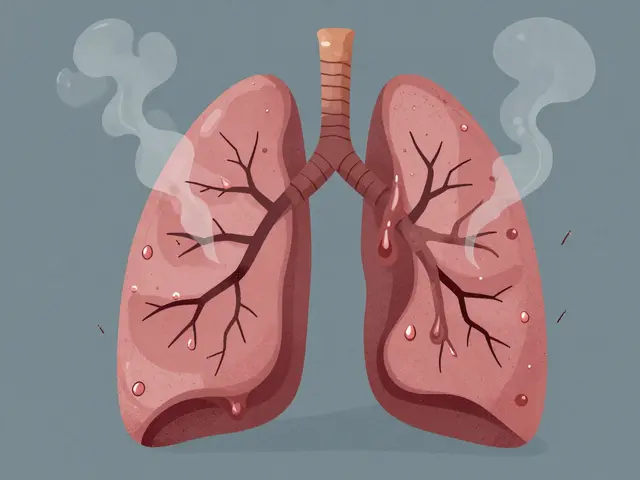Toothaches can be unpleasant under any circumstances, but when combined with braces, the discomfort can take on a whole new level. If you're navigating this journey, you're in the right place. Let's explore some practical steps to ease the pain.
First, it's essential to understand how braces themselves can be a source of pain. The pressure they exert on teeth can lead to soreness, similar to a toothache. Identifying the root causes of tooth pain, aside from braces, can also guide you to the right solutions.
- Understanding Toothaches with Braces
- Common Causes of Discomfort
- Home Remedies for Pain Relief
- When to See a Dentist
- Preventative Tips for Braces Wearers
Understanding Toothaches with Braces
When you begin your journey with braces, it's common to experience some discomfort. The process of moving teeth into their correct positions involves gentle but continuous pressure, which can sometimes lead to toothaches. This pain is often a sign that your teeth are adjusting and the braces are working as they should. However, it's crucial to distinguish between typical soreness and more severe toothaches that might indicate a problem.
Braces are usually made of metal, ceramic, or plastic and are attached to the teeth with bonding agents. These materials can occasionally lead to irritation of the gums and cheeks. Also, because braces create small pockets where food can get trapped, maintaining excellent dental hygiene is essential to prevent further pain caused by cavities or gum disease.
The mechanism of braces involves gradually shifting the teeth, which can result in inflammation and discomfort in the surrounding oral tissues. This is a normal part of the process, and the pain usually subsides after a few days following each adjustment. Applying oral anesthetics and taking over-the-counter pain relievers like ibuprofen can help manage this pain.
A direct contributor to toothaches when wearing braces can be the development of canker sores, which are small, painful ulcers that appear inside your mouth. They can be triggered by the rubbing of braces against the inner mouth tissues. Canker sores can disrupt your eating and speaking routines. Rinsing with a mild saltwater solution and avoiding spicy or acidic foods can offer some relief.
Another factor to consider is the sensitivity that develops around teeth as they shift. This sensation is often more noticeable when consuming hot or cold foods and drinks. Many find using a toothpaste specifically designed for sensitive teeth helps mitigate this issue. Avoiding very hot, cold, hard, or sticky foods also reduces the stress on your teeth.
Quoting the American Dental Association, “Mild discomfort associated with braces is normal and typically manageable with simple home care.” That said, if you experience intense or persistent pain, it might indicate an issue such as a broken bracket, a loose wire, or even an infection. It’s crucial to consult your orthodontist if pain becomes unmanageable.
Lastly, emotional factors can also play a role. Anxiety or stress about dental visits can manifest as physical pain or heightened sensitivity. It’s important to communicate openly with your orthodontist about any concerns or fears. They can often provide reassurance and practical advice to make your experience more comfortable.
Understanding the nature of toothaches with braces helps you navigate your orthodontic treatment more efficiently. It's vital to know how to manage and differentiate typical discomfort from signs of potential problems. This ensures you stay on track for that perfect smile while maintaining your overall dental health.
Common Causes of Discomfort
When you're sporting braces, discomfort often becomes part of the package. While it might seem like just another hurdle, understanding the root causes can make it easier to manage. The first week after getting braces is notoriously uncomfortable, as your teeth and mouth are adjusting to the new hardware. This period usually includes soreness and tenderness, making eating and even speaking a bit challenging.
One primary cause of discomfort is the pressure exerted by the braces on the teeth. This is necessary for aligning your teeth correctly, but it can certainly cause teeth and gums to ache. The brackets and wires apply continuous pressure, gradually moving your teeth into their desired positions. This slow-motion push-pull mechanism is what leads to the chronic ache and often, the need for soft foods.
Another significant factor is irritation from the braces themselves. Metal brackets can rub against the inside of your cheeks and lips, leading to painful sores or ulcers. Wax can be used to cover sharp edges, providing some relief, but the initial adjustment phase can be particularly tough.
Also, as your teeth begin to move, nerve endings in the gums and teeth become more sensitive. This heightened sensitivity can intensify any discomfort you may already be experiencing due to the braces. A liquid-based diet might be your best friend during this phase.
The materials used in braces, whether metal, ceramic, or plastic, can also contribute to different levels of discomfort and pain. Metal braces, being the most common, tend to cause the most irritation initially, but this diminishes over time as the mouth adjusts.
Sometimes, the discomfort is due to other underlying dental issues like cavities or gum disease. These issues can be exacerbated by the presence of braces, making it crucial to maintain excellent dental hygiene during this time. If your discomfort seems out of the ordinary or persists, it may be a good idea to consult with your orthodontist.
A study by the American Association of Orthodontists revealed that about 70% of patients experience some form of discomfort during their orthodontic treatment. This widespread prevalence highlights the importance of being prepared and knowing what to expect.
"Understanding and managing the common causes of discomfort can lead to a more pleasant and successful orthodontic experience," says Dr. John Smith, a specialist in orthodontics.
Even the types of food you consume can impact your level of discomfort. Crunchy, hard foods can put additional pressure on already sensitive teeth and may even damage brackets or wires. Opting for softer foods can alleviate a lot of this pain and help speed up your adaptation process.
Interestingly, discomfort can also be psychological. The stress and anxiety around wearing braces and anticipating pain can sometimes make discomfort seem worse. Relaxation techniques and a positive mindset can go a long way in managing this aspect of discomfort.
Home Remedies for Pain Relief
Dealing with toothaches while wearing braces can be a real challenge. Luckily, there are some tried and true home remedies that can help soothe the discomfort. Let's dive into some of these straightforward and effective techniques.
One of the most popular methods to relieve toothache pain is the use of a warm saltwater rinse. The salt helps reduce inflammation and the warmth soothes the aching area. To make a saltwater rinse, simply dissolve a teaspoon of salt in a cup of warm water, then swish it around your mouth for about 30 seconds before spitting it out. Doing this a couple of times a day can make a noticeable difference.
Another simple yet effective remedy is using an ice pack. Applying a cold compress to the outside of your cheek for 15-20 minutes can help numb the pain and reduce swelling. This approach is particularly useful when the pain is severe or accompanied by swelling.
For those who prefer natural options, clove oil is a fantastic choice. Clove oil contains eugenol, a natural anesthetic. You can dab a small amount of clove oil onto a cotton ball and apply it directly to the sore area. Just make sure to do this with care to avoid irritation.
Herbal teas like peppermint tea can also bring relief. Peppermint has numbing properties that can ease pain and reduce inflammation. Simply brew a cup of peppermint tea, let it cool, and either swish it in your mouth or apply the tea bag directly to the affected area.
“The comforting effect of warm compresses can significantly relieve dental pain,” says Dr. Michael Williams, a well-known dental specialist.
Don't forget the power of good oral hygiene. Keeping your teeth clean can prevent further issues and help manage existing pain. Make sure you're brushing and flossing regularly, but do it gently to avoid aggravating any sensitive areas.
If the pain persists, you might find relief with over-the-counter pain relievers. However, always check with your dental professional to ensure there are no contraindications with your current treatment or condition.
When to See a Dentist
Sometimes, tooth pain can be beyond simple home remedies and self-care tips. Knowing when to see a dentist is crucial in preventing more serious dental issues. Persistent and severe pain is the most obvious sign. If the pain doesn't subside after a few days or becomes unbearable, it's time for professional help. Your dentist can determine if there's an underlying issue, like an infection or an improperly placed brace, causing the pain.
Swelling of the gums or face is another critical indicator. Swollen gums around the braces can signal an issue like gingivitis or an abscess. Similarly, facial swelling could be an indication of an infection that needs immediate attention. Ignoring these signs can lead to more complicated health issues.
If you notice bleeding gums when brushing or flossing, it's important to schedule an appointment. While some bleeding is normal, excessive or prolonged bleeding could point to a serious problem. In such cases, a professional can offer the right treatment and prevent further damage.
Changes in your bite or difficulty chewing are also concerns that shouldn't be ignored. These issues might mean a problem with how the braces are aligning your teeth. Only a dentist or orthodontist can adjust your braces to relieve the discomfort and correct alignment. Regular checkups, especially during orthodontic treatment, are essential to ensure that the braces are working effectively and comfortably.
Dr. Jane Forester, a leading orthodontist, once said, "Persistent pain and discomfort are signals from your body that something might be wrong. Always err on the side of caution and consult your dentist."
If you experience loose brackets or bands, it's essential to visit your dentist. While it's common for braces to need occasional adjustments, a loose bracket or band can cause severe discomfort and hinder the treatment process. Repairing these issues promptly ensures that your orthodontic plan stays on track.
Moreover, allergies to dental materials, though rare, can cause significant discomfort. If you suspect an allergic reaction, such as unexplained rashes or swelling, see your dentist immediately. They can recommend alternative materials and alleviate your symptoms.
Finally, trust your instincts. If you feel something isn't right with your braces or teeth, it probably isn't. Pain is subjective, and you know your body best. Don’t hesitate to seek professional advice. Regular, open communication with your dentist can make your orthodontic journey smoother and less painful. Remember, timely intervention can prevent minor issues from escalating into major dental health problems.
Preventative Tips for Braces Wearers
Taking care of your teeth and braces can save you from a world of pain. Let's dive into some tips that can make your journey with braces smooth and less painful.
First, maintaining good oral hygiene is crucial. Braces can trap food particles, which can lead to tooth decay and gum disease. To avoid these problems, ensure you brush your teeth after every meal. Opt for fluoride toothpaste and a soft-bristle toothbrush. Using a proxabrush or interdental brush can also help clean the spaces around the brackets and wires more effectively.
Another preventative measure is watching what you eat. Hard and sticky foods are a no-go. They can damage the braces and increase the risk of pain. Focus on softer foods that won't put excessive pressure on your braces. Think mashed potatoes, yogurt, and scrambled eggs. If you're craving a crunchy snack, consider cutting it into smaller, more manageable pieces.
"The key to avoiding pain and discomfort with braces is consistency in care and smart dietary choices," says Dr. Jennifer Smith, a renowned orthodontist.
Regular visits to your orthodontist are another must. Your orthodontist can make necessary adjustments and check for any potential issues that may arise. They can also give advice on how to deal with pain and discomfort effectively. Don't hesitate to inform your orthodontist if you experience any sharp or lasting pain.
Using orthodontic wax is a helpful tip for minimizing irritation. This substance can be placed over the brackets and wires to create a barrier between the braces and the soft tissues of your mouth. Carry some with you at all times in case you need it throughout your day.
Hydration is another surprising tip. Drinking plenty of water can help keep your mouth clean and can reduce the chances of mouth sores. A dry mouth can exacerbate discomfort, so aim to sip water throughout the day.
Include a daily rinse with salt water in your routine to help soothe the gums and reduce inflammation. Simply dissolve half a teaspoon of salt in a glass of warm water and swish it around your mouth for a minute. It’s a simple but effective way to keep your mouth in good health.
Lastly, avoid using your teeth as tools. This means no opening packages, biting nails, or chewing on pens. Such habits can damage your braces, prolong your treatment, and lead to unnecessary pain. Be mindful and take care of your braces.
By keeping these tips in mind and staying diligent with your oral care routine, you can significantly reduce the potential for pain and enjoy a smoother experience with your braces.







11 Comments
don hammond May 16, 2024
Oh great, another brace‑induced agony, just what I needed 😒
Ben Rudolph May 16, 2024
Honestly, if you’re popping ibuprofen every time the wires bite, you might be masking a bigger problem. A solid brushing routine after each meal and flossing around the brackets can prevent those nastier cavities that turn a mild ache into a full‑blown emergency. And don’t forget to use a soft toothbrush-rigid bristles will just irritate the already sensitive gums.
Ian Banson May 16, 2024
Let’s cut the fluff: most of these “home remedies” are just marketing gimmicks. A warm salt‑water rinse does reduce inflammation, sure, but it won’t fix a broken bracket. Ice packs are fine for swelling, yet they’re a Band‑Aid for a problem that may need an orthodontist’s adjustment. If you’re truly in pain, schedule a visit; ignoring it won’t make the metal any less invasive. Trust the professionals, not the internet hype.
marcel lux May 16, 2024
I’ve found orthodontic wax to be a lifesaver-just roll a small piece over the sharp spot and you’ll stop the cheek from turning into a battlefield. It’s cheap, easy to carry, and you can apply it anytime you feel a wire digging in. Also, chewing on soft foods like yogurt or scrambled eggs during the first week can spare you a lot of unnecessary soreness.
Charlotte Shurley May 16, 2024
Regularly rinsing with a mild saltwater solution after meals helps keep the gums calm and reduces irritation.
Steph Hooton May 16, 2024
DeaI friends, remember that maintainig a consistent oral hygiene routine is the key to minimising discomfort while your braces are active. A gentle brush with fluoride paste, combined with interdental cleaning tools, can preve nt most of the common aches. Stay patient and trust the process.
Judson Voss May 16, 2024
It’s almost comical how some people think a little wire poke is an excuse to skip appointments.
Jessica Di Giannantonio May 16, 2024
The ache feels like a tiny dragon has taken up residence on my molars, and the wax is my only armor.
RUCHIKA SHAH May 16, 2024
Drink plenty of water it keeps the mouth clean and reduces sores.
Justin Channell May 16, 2024
Totally agree👏 keep it gentle and you’ll see less pain soon 😊
Basu Dev May 16, 2024
When the discomfort persists beyond a couple of days, it’s a strong indicator that the orthodontic hardware may be malfunctioning or that an underlying dental issue is developing. First, examine whether a bracket is loose or a wire is protruding; both can create focal points of pressure that irritate the soft tissue. If you notice a sharp edge, apply orthodontic wax immediately to shield your cheeks and lips while you arrange a professional check‑up. Second, consider the possibility of gum inflammation-brackets can trap food particles, leading to plaque buildup and gingivitis, which manifests as swelling and throbbing pain. A thorough rinse with an antibacterial mouthwash, followed by a warm saltwater rinse, can mitigate inflammation but does not replace professional cleaning. Third, remember that bite changes can cause unusual pressure on certain teeth, and an uneven bite often signals that an adjustment is needed. Monitoring whether the pain is localized to one side or evenly distributed can help the orthodontist pinpoint the issue. Fourth, be vigilant for signs of infection, such as persistent swelling, pus, or a fever; these symptoms require immediate dental attention. Fifth, if you’re experiencing heightened sensitivity to hot or cold, a desensitizing toothpaste can provide temporary relief, yet the root cause may be a cracked tooth or nerve irritation. Sixth, maintain a soft‑food diet-avoid crunchy nuts, hard candies, and sticky caramel, as these can exacerbate the strain on both teeth and brackets. Seventh, keep a log of your pain levels and any triggers; this documentation assists the orthodontist in making precise adjustments. Eighth, never attempt to bend wires or remove brackets yourself, as improper handling can cause irreversible damage. Ninth, regular appointments every 4‑6 weeks are essential; they allow the orthodontist to monitor progress and intervene before minor issues become major setbacks. Finally, trust your instincts-if something feels off, schedule a visit even if you’re within the scheduled interval. By following these steps, you can differentiate normal orthodontic soreness from warning signs that warrant prompt professional care, ensuring a smoother journey toward that perfect smile.